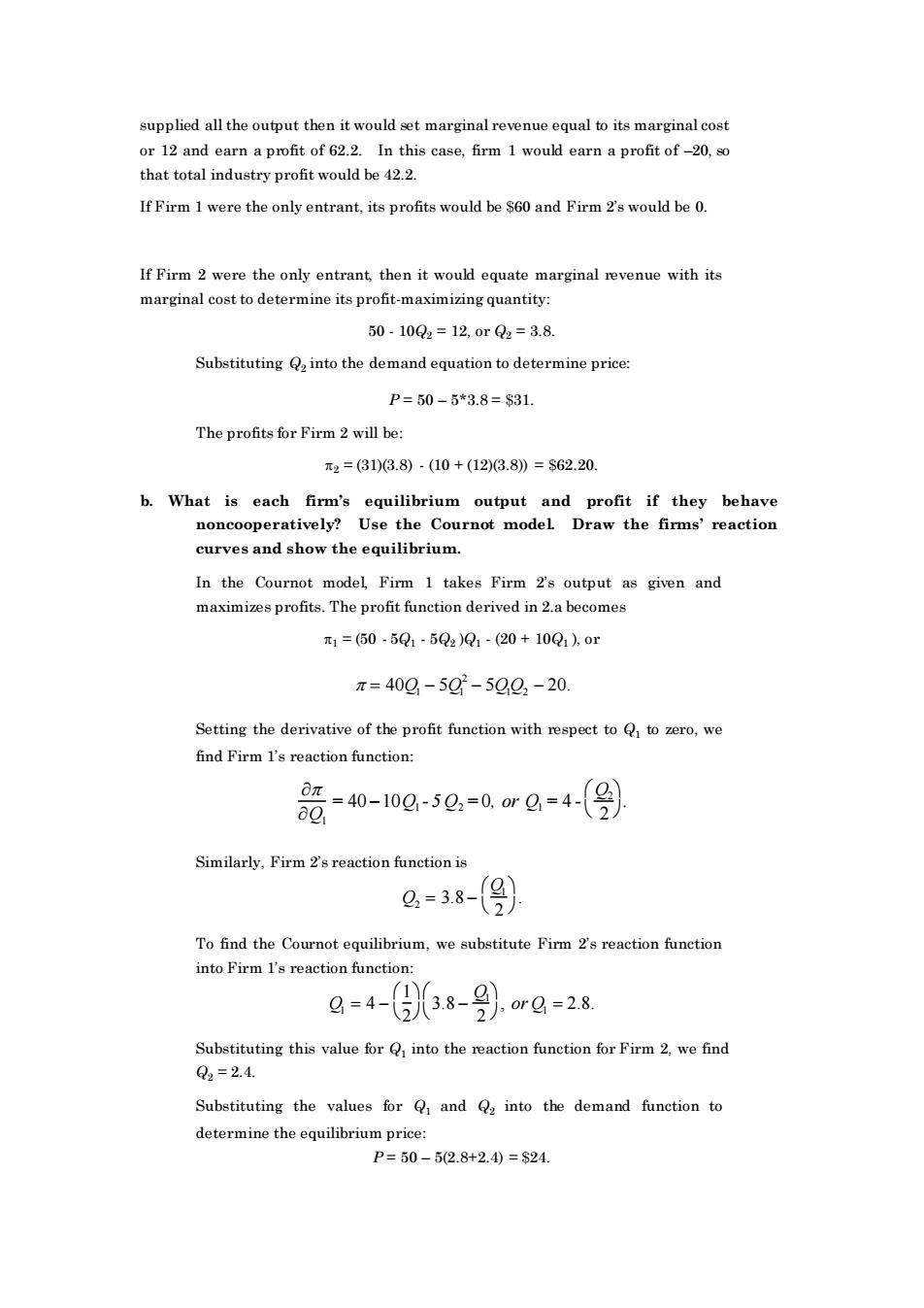正在加载图片...

supplied all the output then it would set marginal revenue equal to its marginal cost or 12 and earn a profit of 62.2.In this case,firm 1 would earn a profit of-20,so that total industry profit would be 42.2. If Firm 1 were the only entrant.its profits would be60 and Firm2s would be 0. If Firm 2 were the only entrant,then it woul equate marginal revenue with its marginal cost to determine its profit-maximizing quantity: 50-10Q2=12.0rQ2=3.8 Substituting into the demand equation to determine price: P=50-5*3.8=$31. The profits for Firm 2 will be: 2=3103.8)·(10+(123.8》=s62.20. b.What is each firm's equilibrium output and profit if they behave noncooperatively?Use the Cournot model Draw the firms'reaction curves and show the equilibrium In the Cournot model Firm 1 takes Firm 2's output as given and maximizes profits.The profit function derived in 2.a becomes 元1=(60.5Q-5Q2)1(20+101o π=40g-5g-5Q22-20. Setting the derivative of the profit function with respect toto zero.we find Firm I's reaction function: ag =40-100-50,=0m2=4-(9》 Similarly,Firm 2s reaction functionis g=38-(》 To find the Cournot equilibrium.we substitute Firm 2's reaction function into Firm I's reaction function: g=4-⑤3.8-)rg=28 1 Substituting this value for into the reaction function for Firm 2,we fin Q2=2.4 Substituting the values for and into the demand function to determine the equilibrium price: P=50-52.8+2.4)=$24supplied all the output then it would set marginal revenue equal to its marginal cost or 12 and earn a profit of 62.2. In this case, firm 1 would earn a profit of –20, so that total industry profit would be 42.2. If Firm 1 were the only entrant, its profits would be $60 and Firm 2’s would be 0. If Firm 2 were the only entrant, then it would equate marginal revenue with its marginal cost to determine its profit-maximizing quantity: 50 - 10Q2 = 12, or Q2 = 3.8. Substituting Q2 into the demand equation to determine price: P = 50 – 5*3.8 = $31. The profits for Firm 2 will be: 2 = (31)(3.8) - (10 + (12)(3.8)) = $62.20. b. What is each firm’s equilibrium output and profit if they behave noncooperatively? Use the Cournot model. Draw the firms’ reaction curves and show the equilibrium. In the Cournot model, Firm 1 takes Firm 2’s output as given and maximizes profits. The profit function derived in 2.a becomes 1 = (50 - 5Q1 - 5Q2 )Q1 - (20 + 10Q1 ), or = 40Q1 − 5Q1 2 − 5Q1Q2 − 20. Setting the derivative of the profit function with respect to Q1 to zero, we find Firm 1’s reaction function: Q1 = 40 −10Q1 - 5Q2 =0, or Q1 = 4 - Q2 2 . Similarly, Firm 2’s reaction function is Q2 = 3.8 − Q1 2 . To find the Cournot equilibrium, we substitute Firm 2’s reaction function into Firm 1’s reaction function: Q1 = 4 − 1 2 3.8 − Q1 2 , or Q1 = 2.8. Substituting this value for Q1 into the reaction function for Firm 2, we find Q2 = 2.4. Substituting the values for Q1 and Q2 into the demand function to determine the equilibrium price: P = 50 – 5(2.8+2.4) = $24